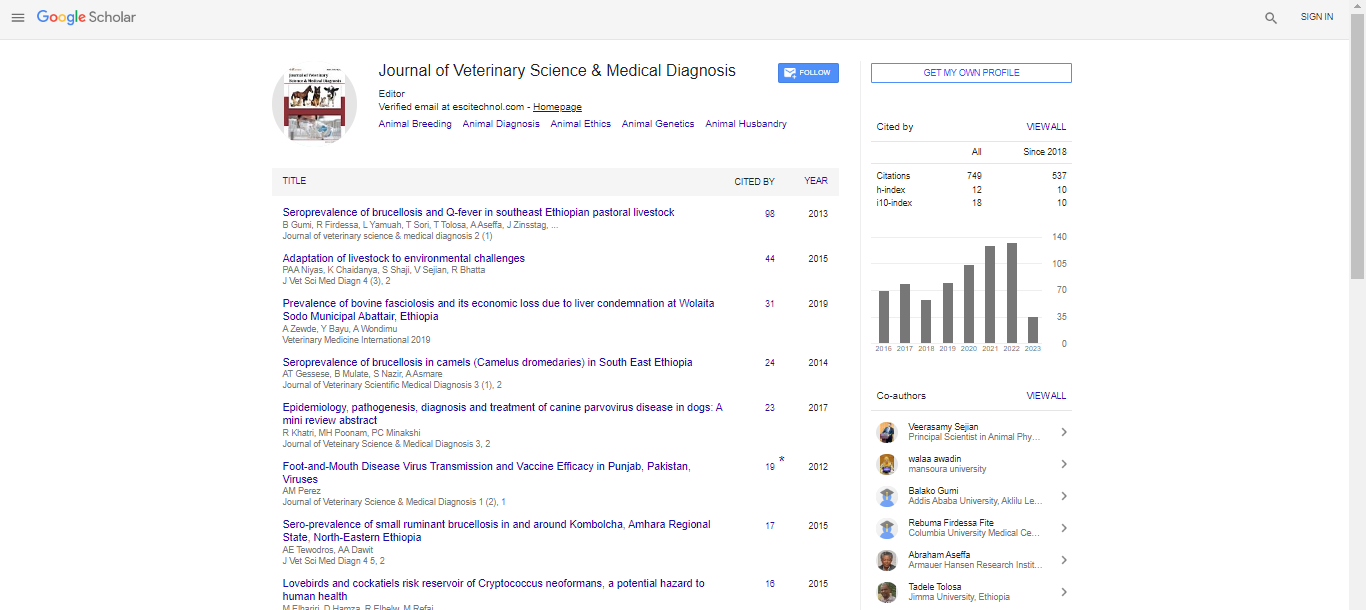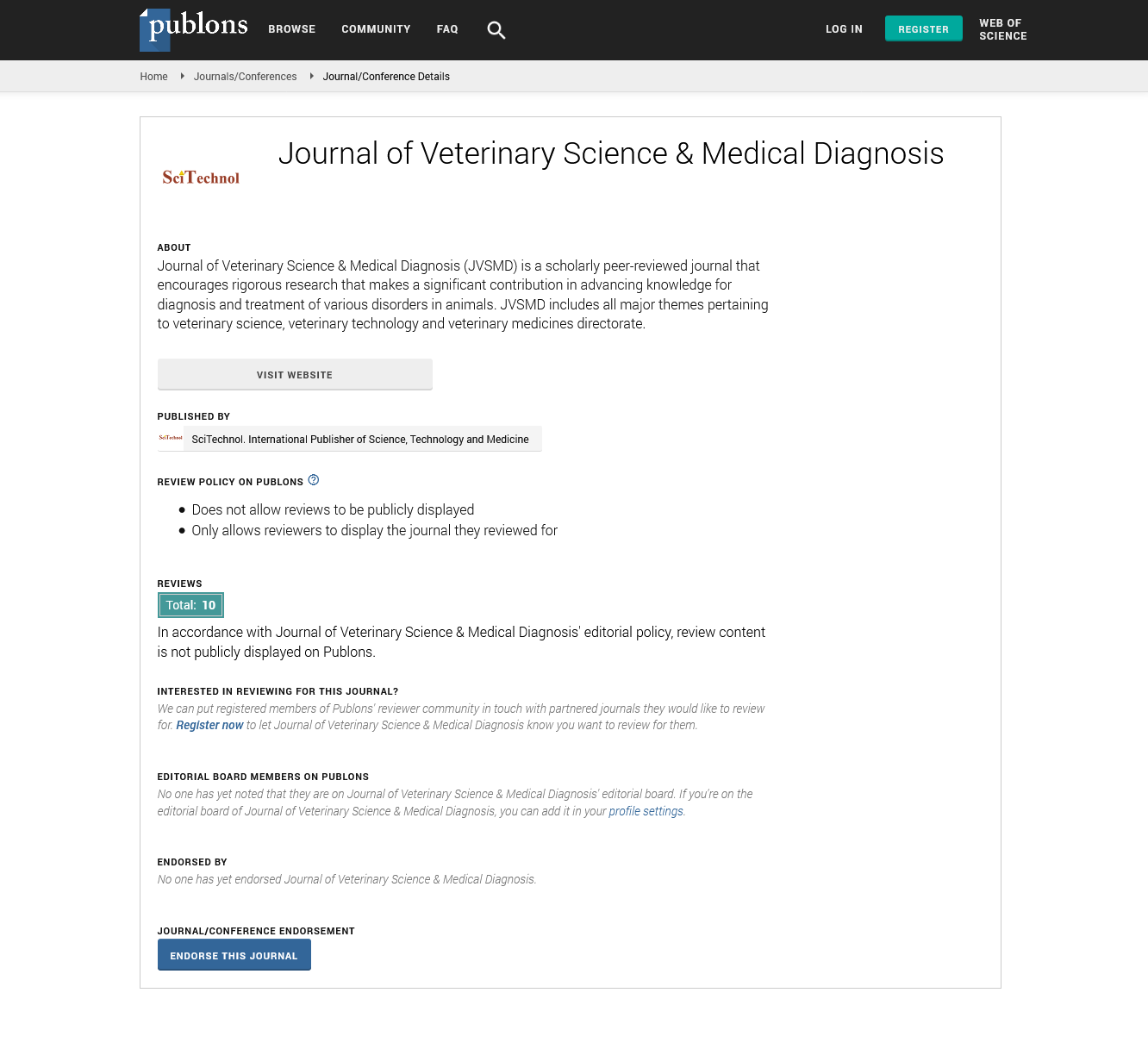Opinion Article, J Vet Sci Med Diagn Vol: 12 Issue: 3
Rehabilitation and Physical Therapy for Pets
Aaron Yang*
1Department of Veterinary Medicine, Nanjing University, Nanjing, China
*Corresponding Author: Aaron Yang
Department of Veterinary Medicine, Nanjing
University, Nanjing, China
E-mail: aa.yang@njb.edu.cn
Received date: 27 April, 2023, Manuscript No. JVSMD-23-100214;
Editor assigned date: 01 May, 2023, Pre QC No. JVSMD-23-100214(PQ);
Reviewed date: 15 May, 2023, QC No. JVSMD-23-100214;
Revised date: 22 May, 2023, Manuscript No: JVSMD-23-100214(R);
Published date: 29 May, 2023, DOI: 10.35248/2325-9590.23.12.100052.
Citation: Yang A (2023) Rehabilitation and Physical Therapy for Pets. J Vet Sci Med Diagn 12:3.
Keywords: Physical Therapy
Description
Rehabilitation and physical therapy are not only important to humans; they are equally essential for our animal companions. Pets can suffer from various injuries, illnesses, or age-related conditions that may hinder their mobility and overall quality of life. In such cases, rehabilitation and physical therapy play a vital role in restoring their physical function, relieving pain, and enhancing their overall wellbeing. There are various techniques employed to improve their health and vitality. They play an important role in improving the lives of pets, particularly those suffering from surgeries or chronic conditions. Through specialized exercises and treatments, pets regain their strength, flexibility, and coordination, enabling them to enjoy a higher quality of life. Physical impairments, rehabilitation and physical therapy not only prevent discomfort but also prevent secondary complications that can arise from prolonged immobility. A thorough evaluation of the pet's condition is conducted to know its range of motion, strength, balance, and overall mobility. This helps to determine the appropriate treatment plan.
Techniques such as massage therapy, hydrotherapy, and therapeutic exercises help relieve pain in pets. These interventions stimulate the release of endorphins, the body's natural painkillers, and promote blood circulation, reducing inflammation and discomfort. Injuries or conditions that affect pets' mobility can be treated through physical therapy. Exercises, stretches, and range-of-motion activities help pets regain strength and flexibility, promoting their ability to walk, run, and play. After surgical procedures, pets may experience limited mobility and muscle weakness. Rehabilitation and physical therapy aid in the recovery process by facilitating tissue healing, reducing scar tissue formation, and preventing postoperative complications. These interventions ensure a faster return to normal function and reduce the risk of reinjury.
Obesity is a common issue among pets, leading to various health problems. If these therapies incorporate exercises which increases a pet's abilities and needs, promoting weight loss, improving cardiovascular health, and reducing strain on joints.
These therapies also aim to restore independence in pets. By enhancing strength, coordination, and balance, these interventions enable pets to perform daily activities with greater ease and reduce their reliance on their owners or caregivers. Water-based exercises are particularly beneficial for pets with musculoskeletal conditions or weight-bearing limitations. Hydrotherapy provides low-impact exercise, buoyancy, and resistance, promoting muscle strength, joint mobility, and cardiovascular fitness. Modalities like electrical stimulation and ultrasound may be used to promote tissue healing, reduce inflammation, and alleviate pain.
Therapeutic exercises involving stretching, range-of-motion movements, and muscle strengthening are designed to target specific areas of concern. These exercises help improve joint stability, rebuild muscle strength, and enhance overall mobility. Massage techniques including effleurage, petrissage, and myofascial release, are employed to promote relaxation, improve blood circulation, and reduce muscle tension. Massage therapy aids in pain management, increases flexibility, and accelerates the healing process. Electrical stimulation is used to activate muscles, reduce muscle atrophy, and relieve pain. It involves the application of low-level electrical currents to targeted muscles or nerves, facilitating muscle contractions and promoting recovery. Acupuncture an ancient Chinese practice involves the insertion of thin needles into the body to stimulate nerves, release endorphins, and restore the flow of energy. Rehabilitation often involves a multidisciplinary approach, with veterinarians, veterinary technicians, physical therapists, and other professionals working together to provide comprehensive care.
 Spanish
Spanish  Chinese
Chinese  Russian
Russian  German
German  French
French  Japanese
Japanese  Portuguese
Portuguese  Hindi
Hindi 
